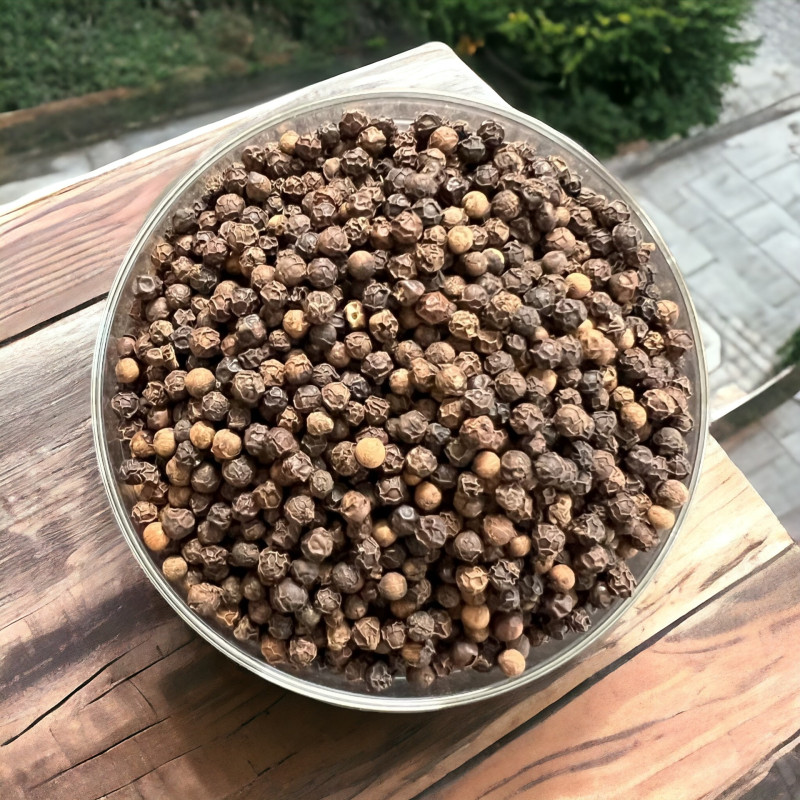- Out-of-Stock




The pepper originating from the Sarawak region is exceptional for its taste and aroma.
It can be enjoyed generously on all your dishes, enhancing them with joy!
 Delivery
Delivery
Mondial Relay
 Returns
Returns
See conditions
 Payments
Payments
100% secure
Produit livré en sachet refermable
Uses in Cooking:
This rare pepper from Malaysia, of superb origin, develops an animalistic, earthy aroma. On the palate, its flavor is powerful, fiery, and very spicy. Its medium-sized grains are very black and slightly wrinkled.
It is probably one of the best peppers in the world, managing to exude a delightfully fresh taste despite the intensity of its heat! It will happily flavor all your dishes, as it is an exceptional pepper!
Who am I?
Origin: Malaysia, Sarawak state
Scientific name: Piper nigrum
Sarawak is one of the two states of Eastern Malaysia located on the island of Borneo. Its territory, situated on the Equator, covers about ¼ of the area of France and is 80% covered by equatorial forest. The quality of the pepper grown here is globally renowned.
Peppers, whether black, white, or green, are the same fruit picked at different stages of ripeness but all come from the same exotic vine: the pepper plant (Piper nigrum).
Piper nigrum produces in order, according to the maturity of its harvest: first green pepper, then black pepper, and finally white pepper. This vine only begins to bear fruit after 7 to 8 years.
Green pepper is picked first, long before maturity. It is preserved in brine or dried. It is strong and pungent, like black pepper, as both retain their skin.
Black pepper is picked when slightly more mature but still before full ripeness. It is reddish in color, and drying turns it black and wrinkles its skin. This skin is what makes it so strong and pungent. This stage of ripening is the most widely used pepper in the world and is known for pairing well with almost all spices.
White pepper consists of fully ripe berries that are soaked to remove their skins and then dried until they turn white. It is considered to be less pungent than black pepper, with a finer taste, and importantly, it does not leave black specks in white sauces.
The cultivation of pepper plants originated from the west coast of India (Malabar coast) in the state of Kerala and has spread to other countries: Southeast Asia (Indonesia and Malaysia), Madagascar, and Brazil. Recently, Vietnam has become the largest global producer of pepper. There are as many varieties and different flavors of pepper as there are places where they are cultivated, somewhat like wine, with terroir and climate playing a significant role in the pepper's taste!
Only the fruits of Piper nigrum (which produces the traditional black, white, and green peppers), Piper cubeba (cubeb pepper), and Piper longum (long pepper) are typically allowed to be called "pepper."
Pepper owes its spicy flavor to amides of piperine.
A Little History:
In Greece, under Alexander the Great, pepper was already in use, as it was among the Romans in antiquity.
Due to their high price, pepper and other rare spices were used as currency after the Arab conquest of Alexandria in 642 CE. This is where the expression "to pay in cash" (derived from "spices") comes from!
The exorbitant price of pepper in the Middle Ages and the monopoly on its trade held by Italy were among the reasons that motivated the Portuguese to find a sea route to India. After Vasco da Gama discovered this route in 1498, a treaty was signed granting the Portuguese exclusive rights to half the world, including the origin of pepper plants in India. A century later, they lost their monopoly to the Dutch (with their East India Company) and the English.
Data sheet
Specific References
 Frederic A.
Frederic A.
Poivre de grande qualité

 Frederic A.
Frederic A.
Poivre de grande qualité

Reference: poivresichuanE
Reference: poivreNEMalabar
Reference: 1N7049301
Reference: 508207101
Reference: 2N70996502
Reference: poivreBEviet
Reference: pimentjamaiqueE
Reference: poivresichuanE
Reference: 10N7699901
Reference: baiepassion
Reference: 6L5609802
Reference: poivresichuanV
Reference: poivreNEmada
Reference: 1N7049301
Reference: poivreNEvietnam
Reference: poivreNEMalabar

The pepper originating from the Sarawak region is exceptional for its taste and aroma.
It can be enjoyed generously on all your dishes, enhancing them with joy!